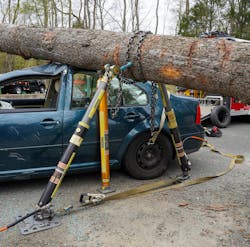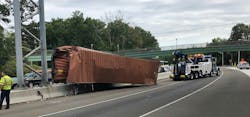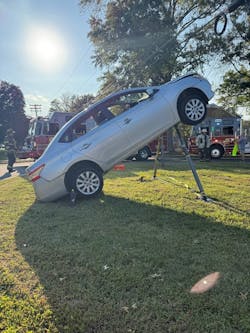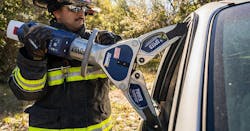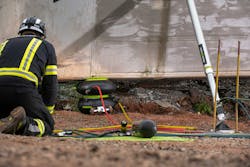Key Takeaways
- Fire department technical rescue operators must consider how to maintain the forces of aerial loads, lateral loads, shear loads, torsional loads and bending moments in alignment beneath an object’s center of gravity when they executive stabilization procedures.
- The four principles of addressing an unstable load at a technical rescue incident are capture, control, reinforce and monitor.
- Drills for technical rescue should include unpredictable variables, such as a strut breaking, the weather changing or a bystander wandering into the hot zone.
Unique loads aren’t the textbook situations where there’s a sedan on its roof or a box truck on its side. They’re the calls that make you stop midstride and think, “Well, I’ve never seen that before”: a collapsed crane boom that’s draped across a city street; a shipping container that’s perched on a highway sign that’s wedged into the roadway; heavy timber beams from a 19th‑century church that hang over a sidewalk. They’re heavy, awkward, shaped wrong, unpredictably balanced wrong and often sit in places where your normal playbook doesn’t fit.
Every unstable load is a conversation that involves gravity, and gravity doesn’t negotiate. Static loads are dangerous; dynamic loads can be lethal. The higher the center of gravity, the faster that things go badly. Liquids slosh, suspended loads sway, debris shifts underfoot. Rain, wind, ice and heat all change the rules. A load can look stable until you touch it, and then it moves in ways that you didn’t predict. That’s why the first tool that you deploy is your brain.
There are several things to think about in a split second that influence how the situation unfolds. Breaking down several components involves understanding the load, stabilization principles, types of equipment that are in your arsenal and executing the operation. The most important is simply understanding physics.
Understand the load
Before you touch a strut, before you drop a crib, stop and read the scene. Where’s the weight? What’s holding it now? What happens if that fails? Slow is smooth, smooth is fast. Respect the load. Treat it as though it’s waiting for you to make a mistake. The best operators don’t just see the load; they understand it and can think ahead.
Everything that we do comes back to four principles:
- Capture. Secure the load’s current position, and if the anchor fails, have a secondary capture ready.
- Control. Prevent unwanted movement, and if the wind picks up, have lateral control lines already in place.
- Reinforce. Build redundancy, and if a strut loses pressure, the crib stack already is there to take the load.
- Monitor. Watch it until it’s done; reassess if needed.
Loads are the forces that an object must handle, moving along a load path from where they are applied to the ground. These forces travel along a defined load path, beginning at the point of application and continuing through the object’s structural elements, connections and supports, until they are ultimately transferred to the ground.
- Axial loads act along the length of an object, either in compression, as with a column that supports weight, or in tension, as with a cable under pull.
- Lateral loads are applied from the side, such as wind that can induce sway or horizontal displacement.
- Shear loads occur when forces attempt to cause one section of a material to slide past another.
- Torsional loads twist an element about its longitudinal axis.
- Bending moments cause curvature in a member, which places one side in tension and the opposite side in compression.
Maintaining these forces in alignment beneath the object’s center of gravity is critical to stability. When the resultant load shifts outside of this point, the likelihood of tipping or collapse increases significantly. A clear understanding of load types, their directions and their paths is essential for constructing stabilization systems that remain safe and stable.
Equipment
The arsenal of equipment is relatively simple. Understand and use what you have.
- Cribbing (box and step). Wood for grip (and tradition); synthetic for weather resistance.
- Wedge. Each with its place.
- Struts. Adjustable, strong, fast, triangulated for strength.
- Air lifting bags. High‑pressure for lift; low‑pressure for spread; always lift an inch and crib an inch.
- Rope systems. Utilized for restraint, not just for rescue; lines that turn sway into stillness, such as tying back ladders on a modified high point.
- Hydraulics. Controlled force for the immovable.
The trick isn’t owning the tools. It’s knowing which one to grab first and how to combine them, so if one fails, the other(s) will hold.
Don’t forget to work with your mutual-aid partners and understand who has what. Maybe those agencies have certain equipment that could benefit your operations and trend the operation toward a better outcome for all who are involved.
The unusual
On scene, chaos is the enemy: One voice for stabilization orders; clear hand signals for noise; a dedicated stability officer who has stop authority. If radios fail, you already briefed regarding hand signals and whistle codes. If multiple agencies arrive with different philosophies, you locked in unified command before tools hit the ground. If the stability officer goes down, the alternate already is assigned.
Execution is about sequencing: size‑up before touch‑up, capture before lift, control before cut, reinforce before release.
What about the out-of-the-box scenarios? The calls where the load writes its own rules? The guide wire gambit, such as a vehicle, nose up, front wheels suspended, balanced on a single utility pole guide wire? Things that can cause worry include the wire snapping back, vehicle shift and live electrical proximity. What could you do? Establish a hot zone? Set up a secondary anchor to tension the wire? Set up high‑point rope rigging and brace with struts? If the wire lets go, the rope already is taking weight. If the pole leans, the utility company dropped power and secured it. If the suspension unloads, no one’s in the drop zone.
An intermodal shipping container that’s wedged high between the uprights of an interstate exit sign and the roadway? Things to think about: a high center of gravity, wind sway, structural fatigue. Initial actions to consider: shut down traffic, aerial access, guidelines to limit sway, heavy wrecker winch in controlled increments to assist in movement. If the sign structure deforms, reinforce it. If wind gusts, stand down or add lines.
The historic church bell tower that partially collapsed? If masonry falls during shoring, work from protected zones. If aftershocks or secondary collapses occur, the sacrificial shoring takes the hit.
APIE
You can’t stage every scenario, but you can build the mindset. Cross‑train with your mutual-aid partners and think specialties, such as crane operators and heavy wrecker crews, and discuss with engineers. Run drills that include unpredictable variables. Inject failures: a strut breaks or pops out of place in the middle of the scenario, weather changes, a bystander wanders into the hot zone.
Teach your people to think in terms of force, not just tools. Build muscle memory for the uncomfortable. It isn’t a matter of whether something will happen but when.
Chiefs, it might not happen during your tenure or during your tour, but when it does happen, those who were involved will be steps ahead to operate, even if it’s as simple as knowing that the situation is too complex and knowing exactly who to call to mitigate the incident.
The APIE process stands for analyze, plan, implement and evaluate, and it helps to guide effective decision-making. Analyze means assessing the situation, identifying hazards and setting priorities. Plan turns that assessment into clear objectives, assignments and resource needs. Implement is executing the plan, coordinating actions and managing resources on scene. Evaluate happens throughout the operation: checking progress, adjusting tactics as conditions change, and ensuring that the response stays safe and effective until the incident is resolved.
APIE is a basic guide for helping anyone to break down what must be done to mitigate an incident. The ability to run through that process mentally in seconds elevates you to another level. That and your experiences and training exponentially increase your potential for successful mitigation with favorable outcomes.
It can shift
Old‑school cribbing wisdom still works. Modern technology just makes it faster. The best crews blend both, honoring the mentors who taught them while embracing the tools that make the job safer.
We don’t just stabilize objects; we stabilize the legacy of the job. The load doesn’t care about your incident action plan or your tools and training. It obeys only physics, and physics is merciless. That’s why we train. That’s why some companies carry more cribbing than some departments carry hose. That’s why we treat every unstable load like it’s alive, because it is.
Product Spotlight
Extrication Equipment Series
The Heavy Rescue Series from AMKUS includes five advanced tools that are engineered for today’s toughest extrications: the Heavy Rescue Spreader, two Cutters, the Combi Tool and the Telescoping Ram (shown). Powered by DeWalt’s FlexVolt battery platform, the tools are crafted from carbon fiber and include the Gator Grip 360-degree handle and the Guardian Angel integrated scene light.
Cloud-Connected Extrication Tools
E3 CONNECT tools from HURST Jaws of Life combine brute force with brainy tech. The cloud-connected extrication tools deliver actionable feedback, automatic tool-use documentation and early error detection, to reduce downtime and boost readiness. With watertight design and smart dashboards, E3 CONNECT is built for today’s toughest calls.
Stabilize/Lift/Push/Crib
The RESQTEC Octopus modular system from Power Hawk Technologies features just four key components, to enable rescuers to lift, stabilize, and extricate efficiently while ensuring safety and control. Because the system provides the ability to save time, reduce costs and maximize space, it’s perfect for trench rescues, building collapses, and shoring and stabilization efforts.
Product Spotlight
Extrication Equipment Series
The Heavy Rescue Series from AMKUS includes five advanced tools that are engineered for today’s toughest extrications: the Heavy Rescue Spreader, two Cutters, the Combi Tool and the Telescoping Ram (shown). Powered by DeWalt’s FlexVolt battery platform, the tools are crafted from carbon fiber and include the Gator Grip 360-degree handle and the Guardian Angel integrated scene light.
amkus.com/heavyrescue
Cloud-Connected Extrication Tools
E3 CONNECT tools from HURST Jaws of Life combine brute force with brainy tech. The cloud-connected extrication tools deliver actionable feedback, automatic tool-use documentation and early error detection, to reduce downtime and boost readiness. With watertight design and smart dashboards, E3 CONNECT is built for today’s toughest calls.
jawsoflife.com
Stabilize/Lift/Push/Crib
The RESQTEC Octopus modular system from Power Hawk Technologies features just four key components, to enable rescuers to lift, stabilize, and extricate efficiently while ensuring safety and control. Because the system provides the ability to save time, reduce costs and maximize space, it’s perfect for trench rescues, building collapses, and shoring and stabilization efforts.
powerhawk.com
About the Author

Robert Policht
Robert Policht, who is a Firehouse contributing editor, is lieutenant of Ladder Co. 2 of the Passaic, NJ, Fire Department. He assisted with developing and establishing the department’s response to human vs. machine incidents and is attached to the Fire Investigation Unit. Policht started his career as a volunteer and has served as a chief of department. He taught at the Bergen County, NJ, Fire Academy and is a member of the NJ Division of Fire Safety's Fire Threat Task Force. Policht has a master’s degree in emergency management and homeland security from Arizona State University and has been published in several trade publications. He is a founder of and contributor to Flow and Vent, which is a website that's dedicated to fire and rescue training.
